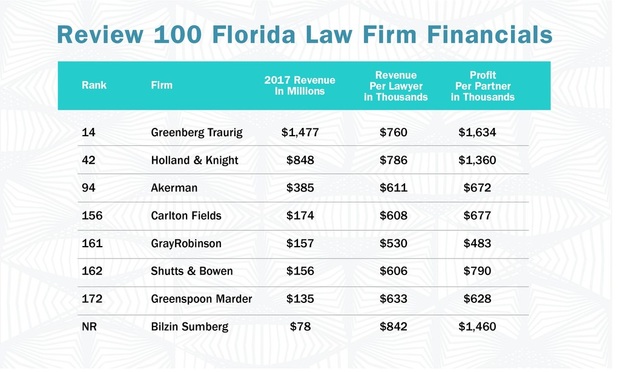In Volatile Market, Big Florida Law Firms Grew Financially — or Just Held On
Large firms in Florida are holding their own for the most part financially. But that means different things depending on the size of the firm.
June 27, 2018 at 03:50 PM
7 minute read
 Am Law 100 Greenspoon Marder
Am Law 100 Greenspoon Marder PROSPERITY AT THE TOP
For the two largest Florida-based firms — Greenberg Traurig and Holland & Knight — healthy revenue growth of 7.2 percent and 5.6 percent, respectively, had no effect on their Am Law 100 rankings, which stayed at 14 and 42. That's unsurprising in a year when the Am Law 100 as a whole saw its gross revenue grow by 5.5 percent. Greenberg Traurig CEO Brian Duffy said, “It was a broad-based and deep, strong year" for the firm, though he noted particular strength in Europe, where the firm has invested in key markets such as Amsterdam, Berlin, London and Warsaw. At Holland & Knight, managing partner Steven Sonberg said the firm has grown by seeking to double down in its strongest areas. That continued in 2017 as the firm added to its global compliance, private wealth, commercial lending and aviation finance capabilities with high-profile laterals. Florida's other Am Law 100 firm, Akerman, climbed a few spots in the rankings to 94th, pushed by gross revenue growth of 10 percent. The firm grew its lawyer head count by more than 6 percent with significant growth in its equity and nonequity partner tiers. The firm did all that in a transition year with Andrew Smulian working side by side with David Spector, who took over in February as chairman and CEO.ON THE SMALLER SIDE
Florida's four Second Hundred firms, however, were competing in a field of firms with a much different story to tell. As a whole, the Second Hundred saw gross revenue decline by 0.2 of a percent in 2017. The discrepancy in performance between Am Law 100 and Second Hundred firms in Florida is a function of size, compensation systems and geography, said Christine Meade, a director in Major, Lindsey & Africa's Miami office. “There are firms in South Florida that have sizable offices in cities like New York, Chicago, San Francisco, Washington, D.C., for example, where billing rates can be higher,” she said. “This can have an influence on these numbers.” Of all seven Am Law 200 firms, Carlton Fields saw the biggest decline as revenue dropped 11 percent, only slightly less than in 2016. Head count declined as well, allowing revenue per lawyer to shrink by just 1.3 percent and profit per equity partner by 3 percent. The firm fell 10 places on the Am Law 200 rankings. CEO Gary Sasso noted Carlton Fields is still the highest-ranked Florida firm in the Second Hundred. The firm benefited from legal work resulting from the Great Recession, and as the economy slowed it saw that work decrease. “2016 and 2017 were part of a cycle for us. It was a dip, and we're growing out of it in 2018,” he said. Sasso said the firm has been focusing on rightsizing head count, including asking some lawyers “to move on,” and building up nonlitigation practices. GrayRobinson also saw PPP decline, by 2.7 percent, even though revenue grew 1.8 percent. That represented a slowdown in revenue growth for the second straight year. In an interview with DBR in December, managing director Mayanne Downs forecast the firm's 2017 revenue but said she expected an increase in profits, noting she had seen growth in government relations and lobbying, real estate and patent-related work and expected that to continue. Of the eight Florida firms that reported financial results, including midsize firm Bilzin Sumberg, only two outside the Am Law 100 saw both revenue and PPP grow. They were Greenspoon Marder and Shutts & Bowen. At Shutts & Bowen, revenue per lawyer eked up 1.3 percent, revenue increased by 3 percent, and PPP grew 4.2 percent. One of the year's highlights was the opening of a Jacksonville office when Shutts & Bowen absorbed Gillis Way & Campbell and five of its six lawyers. Managing partner Michael Grindstaff said financial services, real estate, insurance defense, corporate, construction litigation and commercial litigation were particularly strong practices, while creditors' rights work continued to slow. And one-office litigation firm Bilzin Sumberg experienced a dip in revenue and profitability due in part to its stellar performance in 2016. Gross revenue was off 3.9 percent and PPP down 11.5 percent compared with the year before. “I don't want to give an impression that the prior year is an anomaly and we're done,” managing partner-elect Albert Dotson Jr. said. But the 92-lawyer firm still has a healthy bottom line, with PPP that outranks all but one of Florida's large firms. At $1.46 million, it is second only to Greenberg Traurig. The two fastest-growing firms in Florida were Akerman, which continued a seven-year streak in revenue growth, and Greenspoon Marder, which saw revenue increase by 10 percent, in part thanks to its real estate practice and growing role as adviser to the budding cannabis industry. Greenspoon opened five new offices in 2017 and added nine partners, but head count overall grew by only six lawyers and the equity partner tier shrunk. The firm's net income was nearly flat, but it grew PPP by more than 5 percent. “As a result of years of planning ahead and building a very large, very sophisticated infrastructure, when we do an expansion into a city the additional cost is minimal. It's incremental,” co-managing director Gerald Greenspoon said. “We bring on the new employees with barely an increase in overall staff that increases the associated costs.”
The discrepancy in performance between Am Law 100 and Second Hundred firms in Florida is a function of size, compensation systems and geography, said Christine Meade, a director in Major, Lindsey & Africa's Miami office. “There are firms in South Florida that have sizable offices in cities like New York, Chicago, San Francisco, Washington, D.C., for example, where billing rates can be higher,” she said. “This can have an influence on these numbers.” Of all seven Am Law 200 firms, Carlton Fields saw the biggest decline as revenue dropped 11 percent, only slightly less than in 2016. Head count declined as well, allowing revenue per lawyer to shrink by just 1.3 percent and profit per equity partner by 3 percent. The firm fell 10 places on the Am Law 200 rankings. CEO Gary Sasso noted Carlton Fields is still the highest-ranked Florida firm in the Second Hundred. The firm benefited from legal work resulting from the Great Recession, and as the economy slowed it saw that work decrease. “2016 and 2017 were part of a cycle for us. It was a dip, and we're growing out of it in 2018,” he said. Sasso said the firm has been focusing on rightsizing head count, including asking some lawyers “to move on,” and building up nonlitigation practices. GrayRobinson also saw PPP decline, by 2.7 percent, even though revenue grew 1.8 percent. That represented a slowdown in revenue growth for the second straight year. In an interview with DBR in December, managing director Mayanne Downs forecast the firm's 2017 revenue but said she expected an increase in profits, noting she had seen growth in government relations and lobbying, real estate and patent-related work and expected that to continue. Of the eight Florida firms that reported financial results, including midsize firm Bilzin Sumberg, only two outside the Am Law 100 saw both revenue and PPP grow. They were Greenspoon Marder and Shutts & Bowen. At Shutts & Bowen, revenue per lawyer eked up 1.3 percent, revenue increased by 3 percent, and PPP grew 4.2 percent. One of the year's highlights was the opening of a Jacksonville office when Shutts & Bowen absorbed Gillis Way & Campbell and five of its six lawyers. Managing partner Michael Grindstaff said financial services, real estate, insurance defense, corporate, construction litigation and commercial litigation were particularly strong practices, while creditors' rights work continued to slow. And one-office litigation firm Bilzin Sumberg experienced a dip in revenue and profitability due in part to its stellar performance in 2016. Gross revenue was off 3.9 percent and PPP down 11.5 percent compared with the year before. “I don't want to give an impression that the prior year is an anomaly and we're done,” managing partner-elect Albert Dotson Jr. said. But the 92-lawyer firm still has a healthy bottom line, with PPP that outranks all but one of Florida's large firms. At $1.46 million, it is second only to Greenberg Traurig. The two fastest-growing firms in Florida were Akerman, which continued a seven-year streak in revenue growth, and Greenspoon Marder, which saw revenue increase by 10 percent, in part thanks to its real estate practice and growing role as adviser to the budding cannabis industry. Greenspoon opened five new offices in 2017 and added nine partners, but head count overall grew by only six lawyers and the equity partner tier shrunk. The firm's net income was nearly flat, but it grew PPP by more than 5 percent. “As a result of years of planning ahead and building a very large, very sophisticated infrastructure, when we do an expansion into a city the additional cost is minimal. It's incremental,” co-managing director Gerald Greenspoon said. “We bring on the new employees with barely an increase in overall staff that increases the associated costs.” SHOW ME THE MONEY
Corporate practices in general were moneymakers for the most successful Florida firms. Greenspoon Marder, Holland & Knight, Akerman and Shutts & Bowen all noted 2017 was a lucrative year for their dealmakers. Greenberg Traurig said all of its practices were strong in 2017 but that included some notable transactional achievements — like representing Australia's mall owner-operator Westfield Corp. Ltd. in its $25 billion sale to France's Unibail-Rodamco SE and advising medical device maker Exactech Inc. on its $640 million sale to private equity firm TPG Capital Management LP. Emphasizing transactional practices is a sensible strategy, McKenney said, as litigation makes for less consistent finances. And it may be part of the reason realization improved at Florida firms in 2017, he said. “When the work shifts toward more transactional work, the transactional work tends to be easier to manage,” McKenney said. “We see higher realization for that.”This content has been archived. It is available through our partners, LexisNexis® and Bloomberg Law.
To view this content, please continue to their sites.
Not a Lexis Subscriber?
Subscribe Now
Not a Bloomberg Law Subscriber?
Subscribe Now
NOT FOR REPRINT
© 2025 ALM Global, LLC, All Rights Reserved. Request academic re-use from www.copyright.com. All other uses, submit a request to [email protected]. For more information visit Asset & Logo Licensing.
You Might Like
View All
Law Firms Are 'Struggling' With Partner Pay Segmentation, as Top Rainmakers Bring In More Revenue
5 minute read


As Unpredictability Rises, Gov't Law Practices Expect Trump Bump. Especially in Florida
5 minute readTrending Stories
- 1Gunderson Dettmer Opens Atlanta Office With 3 Partners From Morris Manning
- 2Decision of the Day: Court Holds Accident with Post Driver Was 'Bizarre Occurrence,' Dismisses Action Brought Under Labor Law §240
- 3Judge Recommends Disbarment for Attorney Who Plotted to Hack Judge's Email, Phone
- 4Two Wilkinson Stekloff Associates Among Victims of DC Plane Crash
- 5Two More Victims Alleged in New Sean Combs Sex Trafficking Indictment
Who Got The Work
J. Brugh Lower of Gibbons has entered an appearance for industrial equipment supplier Devco Corporation in a pending trademark infringement lawsuit. The suit, accusing the defendant of selling knock-off Graco products, was filed Dec. 18 in New Jersey District Court by Rivkin Radler on behalf of Graco Inc. and Graco Minnesota. The case, assigned to U.S. District Judge Zahid N. Quraishi, is 3:24-cv-11294, Graco Inc. et al v. Devco Corporation.
Who Got The Work
Rebecca Maller-Stein and Kent A. Yalowitz of Arnold & Porter Kaye Scholer have entered their appearances for Hanaco Venture Capital and its executives, Lior Prosor and David Frankel, in a pending securities lawsuit. The action, filed on Dec. 24 in New York Southern District Court by Zell, Aron & Co. on behalf of Goldeneye Advisors, accuses the defendants of negligently and fraudulently managing the plaintiff's $1 million investment. The case, assigned to U.S. District Judge Vernon S. Broderick, is 1:24-cv-09918, Goldeneye Advisors, LLC v. Hanaco Venture Capital, Ltd. et al.
Who Got The Work
Attorneys from A&O Shearman has stepped in as defense counsel for Toronto-Dominion Bank and other defendants in a pending securities class action. The suit, filed Dec. 11 in New York Southern District Court by Bleichmar Fonti & Auld, accuses the defendants of concealing the bank's 'pervasive' deficiencies in regards to its compliance with the Bank Secrecy Act and the quality of its anti-money laundering controls. The case, assigned to U.S. District Judge Arun Subramanian, is 1:24-cv-09445, Gonzalez v. The Toronto-Dominion Bank et al.
Who Got The Work
Crown Castle International, a Pennsylvania company providing shared communications infrastructure, has turned to Luke D. Wolf of Gordon Rees Scully Mansukhani to fend off a pending breach-of-contract lawsuit. The court action, filed Nov. 25 in Michigan Eastern District Court by Hooper Hathaway PC on behalf of The Town Residences LLC, accuses Crown Castle of failing to transfer approximately $30,000 in utility payments from T-Mobile in breach of a roof-top lease and assignment agreement. The case, assigned to U.S. District Judge Susan K. Declercq, is 2:24-cv-13131, The Town Residences LLC v. T-Mobile US, Inc. et al.
Who Got The Work
Wilfred P. Coronato and Daniel M. Schwartz of McCarter & English have stepped in as defense counsel to Electrolux Home Products Inc. in a pending product liability lawsuit. The court action, filed Nov. 26 in New York Eastern District Court by Poulos Lopiccolo PC and Nagel Rice LLP on behalf of David Stern, alleges that the defendant's refrigerators’ drawers and shelving repeatedly break and fall apart within months after purchase. The case, assigned to U.S. District Judge Joan M. Azrack, is 2:24-cv-08204, Stern v. Electrolux Home Products, Inc.
Featured Firms
Law Offices of Gary Martin Hays & Associates, P.C.
(470) 294-1674
Law Offices of Mark E. Salomone
(857) 444-6468
Smith & Hassler
(713) 739-1250






